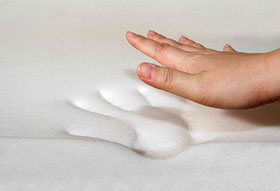
Blog article: The Magic of Memory Foam

Originally named temper foam, and sometimes referred to as "viscoelastic foam", Memory foam was originally developed by NASA in the 1960s for aircraft, as a way of improving comfort and safety. It soon became a commercially available product which is now famous for its use in mattresses and pillows. It is polyurethane foam which has been treated with chemicals that increase viscosity and density.
The "magic" of memory foam and the characteristic it is most famous for is its ability to soften and mold to the contours of a warm body, retaining a "memory" of their shape (hence the name) and then gradually returning to its original shape.
A popular image when you search for memory foam is that of a hand shaped indentation where someone has pressed into it.
During the foam making process, gas bubbles are blown into a liquid base which eventually sets to form either closed cell foam or open cell foam. Closed cell foam is when the gas bubbles are completely fixed within the cell walls, whereas with open cell foam, the bubbles burst, allowing air flow in and out.
The most recent versions of memory foam have the latter open cell structure. The result for the end user of the foam, e.g. a person sleeping on a memory foam mattress, is that the mattress will be breathable and have good temperature regulating properties.
Memory foam is denser than various other foam types, so memory foam mattresses will likely be heavier, but often take less space than a traditional spring mattress. Also, memory foam pillows are less likely to get all bunched up like feather pillows can. Another advantage memory foam has over traditional bedding (spring mattresses, feather pillows and the like) is possibly being more resistant to harbouring dust mites, a known allergen in sensitive individuals.
When purchased as bedding, memory foam products will have been treated with fire retardant chemicals in keeping with current fire regulations.
It is not recommended to allow babies and young children to sleep on memory foam as they are less able to turn themselves over (so also not a good option for parents who co-sleep with babies or young children).
But Memory foam is ok for older children and great for adults of all ages, it particularly has a reputation for being helpful to those with back pain, neck pain and other pain related conditions such as fibromyalgia.

